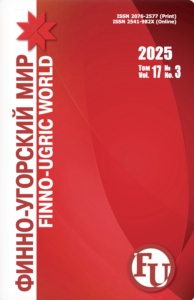“The Biarmiya” by K. F. Zhakov in the translation into the Komi language: the image of Vermort
Ostapova Elena V.,
Candidate Sc. {Philology}, Associate Professor, Department of Finno-Ugric Philology
and National Education, Pitirim Sorokin Syktyvkar State University (Syktyvkar, Russia), ost-1966@yandex.ru
Introduction. The article poses the problem of the accuracy of the translation of the book form of the literary epic “The Biarmiya» into the Komi language on the example of the name structure of Vermort, one of the main characters of the work by K. F. Zhakov “Biarmiya” The relevance of the work is based primarily on the lack of the research of this problem, the need to identify translational transformations while interpreting the text, as well as the characteristics of the reception of the work in reading in the Russian and Komi languages. The theoretical and practical significance of this work is based on the development of Translation Studies both in regional philology and in Finno-Ugric Studies in general. The novelty of the study is that for the first time the accuracy of the translation of the work by K. F. Zhakov “Biarmiya” on the example of the image of Vermort into Komi is analyzed. The object of the study is the work by K. F. Zhakov “Biarmia”; the subject of the study is the specific features of the translation of the image of Vermort into the Komi language. The goal of the work is to reveal the translational transformations of the image.
Materials and Methods. The main method of research is comparative with the use of elements of the static method. The concept of translation is closely connected with the notion of interpreting the text in another language.
Results and Discussion. A special role in the original book belongs to epithets and emotional paraphrases that mark the magical functions of the image of the singer-narrator. The translation into the Komi language of the hero’s name is characterized by brevity and conciseness. Substitutions and omissions lead to a narrowing of the artistic function of the image of Vermort. In the work by K. Zhakov “Biarmiya”, the image of Vermort, a singer-storyteller, reflects and evaluates his magical features, while in translation his song and poetic gift is mainly laconically emphasized.
Conclusion. The obtained results of the research allow making the necessary clarifications in the definition of the genre of the work. Further comprehensive comparative analysis of the original and translation of both the literary epic and the literary epics of the Finno-Ugric peoples will enable us to work out the most acceptable translation solutions. This work can serve to further develop comparative studies in the analysis of book forms of epics.
Key words: Komi literary epic; transfer; the structure of the name; paraphrases; narrowing of the image.
For citation: Ostapova EV. «Biarmiya» K. F. Zhakova v perevode na komi jazyk: obraz Vjermorta [“The Biarmiya” by K. F. Zhakov in the translation into the Komi language: the image of Vermort]. Finno-ugorskiy mir = Finno-Ugric World. 2017; 1: 59–63. (In Russ.)
- Vaneev AYe. K. Zhakovlön “Biarmiya”: poema [K. Zhakovlön “Biarmiya”: a poem]. Böryöm gizhödyas. T. 3. Literatura iylys’ gizhöd”ias, ocherk”ias, vis’t”ias, erta serniias, kaz’tylöm”ias. Syktyvkar; 2007. (In Komi)
- Zhakov KF. Biarmiya: komi literaturnyy epos [Biarmiya: Komi literary epic]. Syktyvkar: Komi kn. izd-vo, 1993. (In Russ.)
- Kotylev AYu. Muzykal’naya igra kak tema, motiv i metafora v proizvedeniyakh K. F. Zhakova [Music play as a theme, motive and metaphor in the works of KF Zhakov]. Muzei i krayevedeniye: tr. Nacion. muzeya Respubliki Komi = Museums and Local History: Study of the National Museum of the Republic of Komi. Syktyvkar; 2001; 3: 316–321. (In Russ.)
- Latysheva VA. Pevets zyryanskogo kraya (Tvorchestvo K. F. Zhakova) [Singer of the Zyryansky Krai (works of K. F. Zhakov)]. Syktyvkar: Komi kn. izd-vo; 2005. (In Russ.)
- Latysheva VA. Tödtom na Komi kyvbur techysyas yylys. Komi Literatura Istoriyas: ucheb. posobie = Komi Literature History: tutorial. Syktyvkarskiy universitet. Syktyvkar; 1995. (In Komi)
- Limerov PF, Sozina YeK. Khudozhestvennyy mir K. F. Zhakova [Artistic world of K. F. Zhakov]. Permskiye literatury v kontekste finno-ugorskoy kul’tury i russkoy slovesnosti: kollektivnaya monografiya = Perm Literature in the Context of Finno-Ugric Culture and Russian Literature: Collective Monograph. Ekaterinburg; Izhevsk; Syktyvkar; 2014: 349–399. (In Russ.)
- Mikushev AK. Komi “Kalevala”. Zhakov K. F. Biarmiya: komi literaturnyy epos = Zhakov KF. “Biarmiya”: Komi literary epic. Syktyvkar; 1993: 5–25. (In Russ.)
- Ostapova YeV. “Kalevala” kak odin iz istochnikov sozdaniya khudozhestvennykh proizvedeniy na komi yazyke [“Kalevala” as one of the sources of the creation of works of art in the Komi language]. Finno-ugorskiy mir= Finno-Ugric World. 2011; 1 (7): 11–15. (In Russ.)
- Ostapova YeV. Khudozhestvoa gizhöd vudzhödöm = Perevod khudozhestvennogo proizvedeniya: velödchan nebög. [Translation of the work of art: Velödchan Nebög]. Syktyvkar: Izd-vo SyktGU; 2012. (In Komi)






















